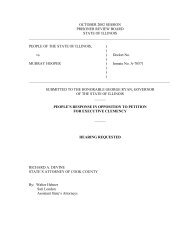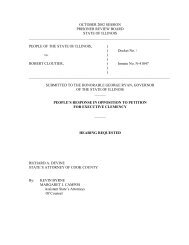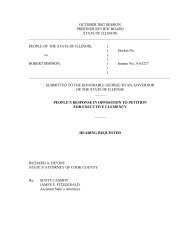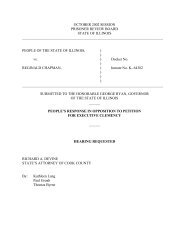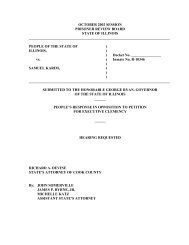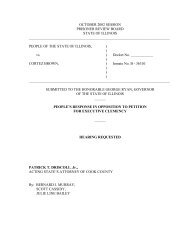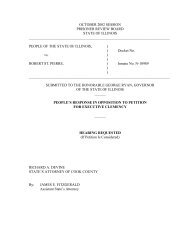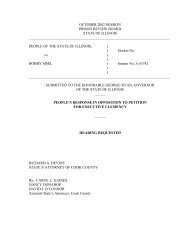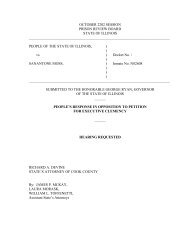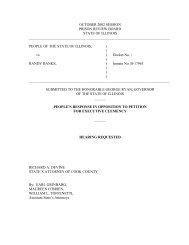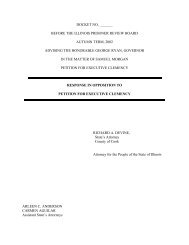Dorothy Williams - Cook County State's Attorney
Dorothy Williams - Cook County State's Attorney
Dorothy Williams - Cook County State's Attorney
Create successful ePaper yourself
Turn your PDF publications into a flip-book with our unique Google optimized e-Paper software.
OCTOBER 2002 SESSION<br />
PRISONER REVIEW BOARD<br />
STATE OF ILLINOIS<br />
PEOPLE OF THE STATE OF ILLINOIS)<br />
DOCKET NO. __________<br />
vs ) INMATE NO. B21483<br />
DOROTHY WILLIAMS )<br />
SUBMITTED TO THE HON. GEORGE RYAN, GOVERNOR OF THE STATE<br />
OF ILLINOIS<br />
PEOPLE’S RESPONSE IN OPPOSITION TO PETITION FOR COMMUTATION<br />
OF DEATH SENTENCE<br />
RICHARD A. DEVINE<br />
STATE’S ATTORNEY OF COOK COUNTY<br />
By:<br />
Lori G. Levin<br />
David A. Stoioff<br />
Celeste Stewart-Stack<br />
1
Introduction<br />
The People of the State of Illinois strenuously oppose petitioner <strong>Dorothy</strong><br />
<strong>Williams</strong>’ request that her death sentence be commuted and further request that the<br />
Prisoner Review Board of the State of Illinois grant a full and complete hearing in<br />
opposition to executive clemency. A full hearing will demonstrate that <strong>Williams</strong> is a<br />
serial murderer of the elderly who has repeatedly and maliciously sought out the frailest<br />
victims, robbed them of their possessions, and cruelly murdered them if they had the<br />
temerity to resist her. <strong>Williams</strong>’ legacy of horror and heartache is rooted in her discovery<br />
of senior citizens’ housing projects, for located in these buildings <strong>Williams</strong> accumulated<br />
and cultivated an endless source of helpless victims.<br />
These havens for the elderly became <strong>Williams</strong>’ hunting grounds. Using various<br />
ruses to gain access to the seniors, <strong>Williams</strong> used her cunning to move freely through the<br />
buildings in search of quick cash and easy prey. As her crimes mounted and the residents<br />
became more fearful and wary, <strong>Williams</strong> simply became more cunning, ruthless and<br />
brutally violent. Whether posing as a worker, or simply asking a kind-hearted soul for a<br />
glass of water, <strong>Williams</strong> entered homes and ended lives, simply because she wanted a<br />
few bucks.<br />
For pocket money, <strong>Williams</strong> beat and stabbed her three murder victims. Despite<br />
their frailty these people fought hard for their lives and died slow, painful and, as a result,<br />
chillingly horrific deaths. It is shameful that these victims lived long and fruitful lives<br />
2
only to die during every person’s worst nightmare: a home invasion by a brutal stranger.<br />
These helpless seniors, frail with age and medical disabilities, opened their doors to<br />
terrifying deaths, inflicted by a worthless criminal who has no place in civilized society.<br />
<strong>Williams</strong> is a street cunning, brutal murderer convicted with overwhelming<br />
physical, forensic, and testimonial evidence. <strong>Williams</strong> gave three court-reported<br />
confessions to three separate murders of senior citizens. She has never claimed actual<br />
innocence. Through extended fitness hearings and expert evaluations it has been<br />
demonstrated that she attempted to translate her street smarts to forensic psychiatry and<br />
failed miserably. These hearings exposed her as a manipulative malingerer, still trying to<br />
avoid responsibility for her heinous and callous acts. As set out below, <strong>Williams</strong> was<br />
convicted by overwhelming evidence and sentenced due to overwhelming aggravation.<br />
To even consider commuting her sentence would be the ultimate travesty of justice by<br />
violating these elderly victims’ dignity yet again<br />
On April 18, 1991, the Honorable Judge Shelvin Singer sentenced <strong>Dorothy</strong><br />
<strong>Williams</strong> to death in case No. 89CR-20869, for the first-degree strangulation murder and<br />
robbery of 97-year-old Mary Harris. As the Illinois Supreme Court unanimously stated,<br />
“the evidence of guilt marshaled by the State against the defendant was overwhelming.”<br />
People v. <strong>Williams</strong>, 164 Ill.2d 1, 27, 645 N.E.2d 844, 853 (1994). Her fingerprints were<br />
found at the scene. The proceeds of the robbery were found at her home, there was a<br />
witness placing her at the scene. Moreover, the defendant confessed before a courtreporter<br />
to the murder of Mary Harris.<br />
After the defendant was sentenced to death she plead guilty to three other cases<br />
where she victimized frail senior citizens. She was sentenced to natural life in 89CR-<br />
3
20870 and 89CR-20871, the felony murders of seniors Lonnie Laws and Caesar Zuell.<br />
The defendant was also sentenced to 7 years in the penitentiary for the robbery of wheelchair<br />
bound Jasper Irving. The evidence in all of these cases showed that the defendant<br />
preyed on the weak, feeble and elderly in their own homes.<br />
<strong>Dorothy</strong> <strong>Williams</strong>’ conviction and sentence were unanimously affirmed by the<br />
Illinois Supreme Court in 164 Ill.2d 1 (1994). A post-conviction petition where she<br />
alleged a myriad of mental health issues that she was denied by Judge Shelvin Singer on<br />
August 20, 1999. At that time Judge Singer found that “there was overwhelming<br />
competent evidence from the record of the trial court proceedings which reveals<br />
convincingly that petitioner was not illiterate and did not have impairment of her<br />
intellect.” The testimony adduced at this lengthy, protracted hearing lasted several days<br />
and consists of hundreds of pages of transcript. A copy of Judge Singer’s fifty-page<br />
ruling is appended to this response. The Illinois Supreme Court recently found that Judge<br />
Singer should have addressed the issues of fitness for post-conviction proceedings and<br />
the allegations within the post-conviction petition separately and has remanded the case<br />
for a hearing on the merits of the post-conviction petition. The Court did not rule on the<br />
merits or lack thereof of defendant’s claims. People v. <strong>Williams</strong>, __ Ill.2d__, 2002 Ill.<br />
Lexis 340 (2002).<br />
There exists a voluminous amount of evidence establishing <strong>Dorothy</strong> <strong>Williams</strong><br />
systematically robbed and killed seniors on the South Side of Chicago over a three to<br />
four year period. She also introduced her daughter Cherika <strong>Williams</strong> to a senior, who<br />
Cherika in turn robbed, following defendant’s death sentence. <strong>Dorothy</strong> <strong>Williams</strong> was<br />
clinically and judicially found to be a malingerer, or faker, on the issue of her alleged<br />
4
mental disability. Notwithstanding the above, the defendant is asking for executive<br />
clemency claiming that she is mentally retarded.<br />
The People vehemently oppose this request.<br />
Facts of the Case<br />
On July 25, 1989, 97-year-old Mary Harris spent five hours of her last day on earth<br />
with her daughter Marian at Mary’s apartment at 4030 South Lake Park in Chicago. Mary<br />
had lived in apartment 1204 of the Chicago Housing Authority Senior Building since the<br />
late 1960's or early 1970's. When Marian left her mother at 2:30 p.m., Mary Harris was in<br />
good health and wore a pink scarf around her head.<br />
At 8 p.m., elderly friends of the victim found her door ajar. She was discovered<br />
dead, with her kerchief around her neck. The police were summoned and her daughter was<br />
called.<br />
Detectives Patrick McDonald and Thomas Grady went to the victim's apartment<br />
and discovered no sign of forced entry. They observed Mary Harris lying on her bed. Both<br />
of Ms. Harris' eyes were blackened and a pink scarf was knotted around her neck. Dresser<br />
drawers were open and in disarray, as was her closet. Evidence technicians found<br />
fingerprint impressions on five items that were sent to the crime laboratory.<br />
When Marian Harris entered her mother's apartment that night, she too saw that<br />
it had been ransacked. A Realistic Clarinet Sixteen, a small stereo, was missing as well as<br />
a small cardboard box and a lightweight sheer bedspread. Marian Harris identified the<br />
stereo at the police station after it had been recovered from defendant's apartment.<br />
Seventy-one-year old Hubert Carmichael reported to the police that at 6:30 p.m.,<br />
while he was in the day room on the first floor of 4030 S. Lake Park, he saw the defendant<br />
leaving the building alone carrying a box large enough to hold the missing stereo set. He<br />
had seen the defendant many times before and knew she had no legitimate reason to be in<br />
5
the senior citizens building, she did not live there, had no relatives there, and did not work<br />
there.<br />
It was Mr. Carmichael who helped the police solve Mary Harris’ murder. On<br />
September 6, 1989, he saw the defendant, who had died her hair red and was wearing<br />
glasses, with another woman, walking away from the corner bus stop. Mr. Carmichael<br />
excitedly pointed defendant out to Officer Betty Woods. He told her what he had seen the<br />
night of the murder and that he had also seen at another time the defendant choke another<br />
elderly resident of the building.<br />
Officer Woods, a senior citizens officer for the Chicago Police Department,<br />
approached the two women. Officer Woods spoke with defendant and her companion.<br />
Defendant lied to Officer Woods, saying that her name was "Deborah" <strong>Williams</strong>. Officer<br />
Woods transported the two to the Area One Detective Division.<br />
The defendant continued to claim she was Deborah <strong>Williams</strong> to the detectives.<br />
After being advised of her rights, she initially stated she had not been in the 4030 Lake<br />
Park building in years and that she did not know the victim.<br />
Following this conversation, defendant signed a consent to search form. The<br />
officers went to defendant's apartment and recovered a Realistic Clarinet Number Sixteen<br />
stereo with two speakers. As the evidence against her mounted, the defendant began to<br />
change her story bit by bit. When confronted with Mary Harris’ stereo, <strong>Dorothy</strong> <strong>Williams</strong><br />
admitted it belonged to her. Defendant stated that she had purchased the stolen stereo<br />
approximately one month earlier from an unknown male black. Defendant could not<br />
estimate the person’s age, weight, height or complexion. After this conversation an<br />
evidence technician was called to take defendant's fingerprints.<br />
The defendant then admitted that she previously gone to 4030 S. Lake Park, but<br />
stated that she had never been on the victim’s floor. Once again she claimed she could not<br />
describe the person from whom she bought the stereo.<br />
6
After speaking with Assistant State’s <strong>Attorney</strong> Thomas Bilyk, <strong>Dorothy</strong><br />
<strong>Williams</strong>, using her true name, gave a handwritten statement, which she read and signed in<br />
three places. Defendant stated that she was in the victim's building on the evening of the<br />
murder to visit her friend "R.L." She met Clyde in the elevator and agreed to buy a stereo<br />
from him. They went to the twelfth floor and Clyde opened the victim's door with a key.<br />
The victim was "already moaning." Clyde went in and choked the victim with both hands.<br />
When he finished choking the victim, defendant gave Clyde twenty dollars and lifted the<br />
stereo set off of a dresser. Defendant and Clyde left the building together, Clyde carried<br />
the stereo set out of the building. They walked together to defendant's apartment.<br />
When a detective confronted her with the fact that Hubert Carmichael had seen<br />
her leave the building alone carrying a box, the defendant changed her story once again. In<br />
this final version, which was subsequently witnessed by Assistant State’s <strong>Attorney</strong> Michael<br />
Jacobs and transcribed by a court reporter, the defendant stated that she had gone to the<br />
victim's apartment looking for money to buy heroin. Defendant knocked on Mary Harris'<br />
door and was admitted by Ms. Harris. The two had a short conversation. Ms. Harris gave<br />
defendant two dollars to go buy her some milk. When Ms. Harris turned, defendant<br />
wrapped her arms around the victim's waist, pulled her tight and the victim started<br />
screaming. To silence her, the defendant took the "little rag" that Ms. Harris was wearing<br />
on her head and pulled it tight into the victim's mouth. The struggle continued and Ms.<br />
Harris scratched at defendant. The "rag" came down around Ms. Harris' neck and<br />
defendant tightened it.<br />
Ms. Harris lost consciousness and defendant dragged the victim's<br />
body into the bedroom. Ms. Harris' body was cold to the touch. Defendant took the stereo<br />
set and left the apartment.<br />
After the statement was typed, the defendant read the first page of the statement<br />
out loud, initialed each page and signed the final page of her statement.<br />
Additionally, an expert determined that the defendant’s fingerprints had been<br />
found on two items in Mary Harris’s apartment, a gift box and a business card.<br />
7
Dr. Robert J. Stein, the Chief Medical Examiner of <strong>Cook</strong> <strong>County</strong>, performed<br />
Mary Harris’ autopsy. Dr. Stein observed a "ligature," a pink handkerchief that was<br />
knotted tightly around Ms. Harris' neck. Dr. Stein removed the handkerchief and saw an<br />
abrasion on Ms. Harris' neck. The victim also suffered two black eyes, caused by separate<br />
blows, and small hemorrhages in the whites of the eyes that were consistent with<br />
strangulation.<br />
His internal examination showed a hemorrhage to the neck and a hemorrhage to<br />
the 'strap' muscles.<br />
Her hyoid bone, which sits above and behind the adam's apple, was<br />
fractured. Dr. Stein determined that seventeen pounds of pressure per square inch must<br />
have been exerted to fracture the hyoid bone. Dr. Stein's expert opinion was that Mary<br />
Harris died from ligature strangulation.<br />
The defense offered no evidence at trial. Both sides presented closing arguments<br />
and the jury was instructed on the applicable law. The jury found defendant guilty of<br />
murder and robbery.<br />
Death Penalty Hearing<br />
The defendant waived a jury for purpose of the sentencing hearing. After the<br />
first phase of the hearing was completed, Judge Singer concluded that the killing of Mary<br />
Harris was executed during the completion of a robbery and found <strong>Dorothy</strong> <strong>Williams</strong><br />
eligible for the death penalty.<br />
During the second phase of the death penalty hearing, extensive evidence was<br />
presented showing how the defendant preyed on the elderly. As the Supreme Court noted,<br />
“The evidence indicated in order to gain entrance to the apartments of many of these<br />
elderly persons, as well as the apartments of still others, defendant used various ruses,<br />
including the pretense that the resident knew or was related to her and the deception that<br />
8
the defendant had come to aid the resident. The evidence indicated that defendant was often<br />
physically abusive of these elderly persons whom she robbed.” 164 Ill.2d at 25.<br />
Testimony was given concerning the two felony murders, 89CR-20870 and<br />
89CR-20871, of senior citizens Lonnie Laws and Caesar Zuell which the defendant<br />
subsequently plead guilty to and was sentenced to natural life by the Honorable Judge<br />
James Heyda. The defendant has never challenged the validity of those convictions or<br />
sentences.<br />
With respect to the murder of 79-year-old Lonnie Laws, on December 5, 1987 a<br />
police officer was dispatched to 4218 South Cottage Grove, apartment 710 and found<br />
Lonnie Laws motionless on his apartment floor. Two articles of clothing were wrapped in<br />
a gag-like fashion around Mr. Laws face and a belt was wrapped tightly by around his<br />
neck. As in the case of Mary Harris, this apartment was in disarray, the closet was<br />
rummaged through and clothes were thrown on the floor. There was no sign of forced<br />
entry. A wallet was opened on the bed, drawers were open and the contents were strewn<br />
about the room.<br />
Due to the similarities between the two murders, the defendant was questioned<br />
regarding the murder of Lonnie Laws while in custody for Mary Harris’ murder. The<br />
defendant gave another court-reported confession to Assistant State’s <strong>Attorney</strong> Jacobs.<br />
Defendant stated that on the date of the murder she had sex with Mr. Laws, who was<br />
intoxicated and "wild.” When defendant asked for money, Mr. Laws told defendant she<br />
would have to come back for it. Defendant went through Mr. Laws' drawers when he cut<br />
defendant with a knife. Defendant got angry and grabbed Mr. Laws.<br />
According to<br />
defendant, she gagged him with a belt that was hanging around his neck and asked for her<br />
money. When Mr. Laws did not give defendant the money, defendant tightened the belt<br />
around his neck and pushed Mr. Laws down. Defendant took the money from Mr. Laws'<br />
robe and left.<br />
9
The parties agreed that the defendant’s fingerprint was recovered from the<br />
exterior door of Mr. Laws' apartment. The parties also stipulated that the autopsy revealed<br />
Mr. Laws was five feet five inches tall and weighed 94 pounds. Mr. Laws suffered<br />
hemorrhaging in both eyes and abrasions to his face and nose. Mr. Laws was gagged with<br />
a pajama top that was tied in the back of the neck. Around Mr. Laws' neck was a belt.<br />
Between Mr. Laws' eyebrows were multiple, irregular areas of abrasion and bruising.<br />
Internal examination revealed multiple areas of hemorrhaging in the neck, throat,<br />
esophagus and tongue and a fracture of the thyroid cartilage. The autopsy determined that<br />
Lonnie Laws died of ligature strangulation. His blood alcohol level was well below the<br />
legal definition of intoxication.<br />
Concerning the murder of Caesar Zuell, on December 6, 1988 another officer<br />
was summoned to apartment 813 at the senior building at 740 East 43rd Street. Upon<br />
entering the apartment, the officer observed the decomposed body. The fire department<br />
was called, and air tanks were requested because of the unbearable stench emanating from<br />
the apartment.<br />
The parties agreed to the testimony that an evidence technician found a latent<br />
fingerprint impression from a whiskey bottle in Caesar Zuell's apartment and sent it to the<br />
crime lab. The parties also stipulated that an expert fingerprint examiner, found the<br />
defendant's palmprint on that bottle.<br />
Both sides also agreed to the results of Caesar Zuell’s autopsy. It showed<br />
Caesar Zuell was five foot, seven inches, weighed 120 pounds and was sixty-four years old.<br />
Mr. Zuell's body exhibited skin slippage and discoloration indicating decomposition. Mr.<br />
Zuell died from three stabs wounds to the chest and a lacerated lung.<br />
Assistant <strong>State's</strong> <strong>Attorney</strong> Gabriel DeMatteo testified he took a court-reported<br />
statement from the defendant on September 8, 1989. The defendant told him in December<br />
of 1988 she got a call from Caesar Zuell asking defendant to have sex with him for fifty<br />
dollars. After purchasing a pint of whiskey, she went to Mr. Zuell's. Mr. Zuell did not<br />
10
want to pay defendant, so she wrestled with him trying to go into his pockets. Mr. Zuell<br />
told defendant to leave his apartment brandishing a pocket-type knife. Defendant grabbed<br />
Mr. Zuell by the wrist and pushed the knife into his chest. After this struggle, defendant<br />
reached into Mr. Zuell's pocket, took eighty seven dollars and left. She claimed Mr. Zuell<br />
was still standing when she took the money.<br />
During the death penalty hearing, there was additional evidence concerning the<br />
defendant’s victimization of the elderly. Seventy-two year old Jasper Irving was wheeled<br />
into the courtroom. He testified that he suffered from cancer of the vocal chords and had<br />
been using a walker for fifteen or twenty years. On January 11, 1986, Mr. Irving was living<br />
at the senior citizen’s building at 4949 South Cottage Grove. On that day, the defendant,<br />
who Mr. Irving had seen in the building before, knocked on Mr. Irving's door. When the<br />
defendant stated she wanted some beer, Mr. Irving put two dollars on the table. The<br />
defendant stated it was not enough, grabbed the money that Mr. Irving was holding in his<br />
hand and the two dollars off the table and fled. After defendant left, Mr. Irving called some<br />
former neighbors who were familiar with defendant who told Mr. Irving defendant's name.<br />
Mr. Irving then called the police. One week later Mr. Irving identified the defendant for<br />
the police.<br />
Defendant was arrested, released on bond and never appeared in court to answer<br />
these charges. On April 4, 1989, Mr. Irving was in his apartment at 4949 South Cottage<br />
Grove when someone knocked on his door. The person outside Mr. Irving's door told him<br />
there was a gas leak. Mr. Irving cracked open the door and saw defendant. She forced her<br />
way into his apartment, knocking him to the floor. Defendant beat him in the head with a<br />
stick and Mr. Irving fell backwards. Defendant then put her foot in the victim's face, got a<br />
dishtowel and tied it around Mr. Irving's throat. Defendant then tightened the towel and<br />
dragged him to the front of the apartment and said, "I don't know what I'm going to do with<br />
you." Mr. Irving told defendant where he had two hundred and sixty dollars hidden and<br />
she released him. Defendant took the money and Mr. Irving's key and left the apartment.<br />
11
Mr. Irving called the police and identified her from a group of photographs. Two<br />
years later defendant was apprehended and Mr. Irving went to court and identified<br />
defendant. Mr. Irving testified that his skull was fractured as the result of the beating he<br />
received from defendant. At the time of her arrest for Mary Harris’ murder, defendant had<br />
an outstanding bond forfeiture warrant for this second robbery of Mr. Irving. Following<br />
defendant’s sentence of death, she plead guilty to that robbery in Case No. 89CR-3376 and<br />
was sentenced to 7 years in the penitentiary by Judge Heyda. Once again, defendant is not<br />
challenging this conviction or sentence.<br />
The People also presented evidence that the defendant had robbed three other<br />
seniors in Mary Harris’ building or in surrounding senior buildings, Frederick Adamson on<br />
July 4, 1989; Clyde Simmons on July 1, 1989, and Martha Foster on April 4, 1989. The<br />
defendant’s July 4, 1989 robbery of Adamson was the third time she had victimized him.<br />
During the first robbery of Adamson, she had squeezed his tongue and pulled it. During the<br />
Simmons robbery, she had twisted his genitals and threatened to pull off his penis if he did<br />
not give her money.<br />
On August 2, 1989, a mere eight days after she killed Mary Harris, the defendant<br />
was arrested for trespassing in the senior citizen building at 400 East 41 st Street. In this case<br />
her attempt to enter a senior’s apartment by ruse was thwarted. The defendant had already<br />
dyed her hair red claimed that her identity was her deceased sister Peggy <strong>Williams</strong> when<br />
she was arrested and questioned by the police.<br />
Additional evidence showed that in October of 1973, the defendant hit Emma<br />
Lipsey with a 18 square inch wooden milk crate, knocking out two of her lower teeth. On<br />
May 30, 1973, defendant kicked and stuck a police officer 10 to 12 times in the face and<br />
chest after he arrested her for creating a disturbance. Defendant was convicted and fined for<br />
resisting arrest. On March 10, 1975, defendant was convicted of delivery and possession of<br />
marijuana and was sentenced to 18 months misdemeanor probation and fined $200. While<br />
12
defendant was incarcerated pending her trial for Mary Harris’ murder, she verbally abused<br />
and threatened a female correctional officer.<br />
In mitigation, the defendant presented testimony that while pending trial, her<br />
only disciplinary violation was the November 23, 1989 offense. Defendant’s mother, Annie<br />
Pearl <strong>Williams</strong> testified that the defendant’s deceased father’s contact with her had been<br />
limited essentially to “writing.” Annie Pearl <strong>Williams</strong> testified that the defendant had<br />
attended school until she became pregnant with Cherika at 15. At no time did Annie Pearl<br />
<strong>Williams</strong> testify that the defendant was unable to read this correspondence or that she was<br />
of limited intelligence. Annie Pearl <strong>Williams</strong> testified that at the time of the hearing<br />
defendant’s daughter Cherika was 22 years old and her son Terrance was 20. Cherika<br />
testified that she had been raised by her mother and had a normal upbringing. (As<br />
previously noted, subsequent to the defendant’s sentence of death, Cherika <strong>Williams</strong> plead<br />
guilty to the July 3, 1992 aggravated battery to a senior citizen of 80-year-old Nathaniel<br />
Crenshaw in case 92CR-17216. In her statement to the police, Cherika stated that she had<br />
been introduced to Crenshaw by her mother and that she was attempting to take money<br />
from him when she cut him with a knife (see appendix).<br />
The defense presented no other evidence in mitigation. After both sides<br />
presented arguments, Judge Singer found that no mitigating factors existed sufficient to<br />
preclude the sentence of death.<br />
Petitioner’s Allegations<br />
Petitioner claims that her death sentence should be commuted in light of Atkins v.<br />
Virginia, 122 S. Ct. 2242 (2002), because she is allegedly mentally retarded. Although<br />
the court in Atkins noted that mental retardation is characterized as having a significantly<br />
sub-average general intellectual functioning and significant limitations in adaptive<br />
13
functioning in at least two skill areas with the onset prior to age 18 (122 S.Ct. at 2245<br />
n.3), the Court expressly stated that it was not adopting a definition of mental retardation<br />
and left it to the various states to adopt a definition of mental retardation and delineate<br />
procedures for determining whether or not a particular defendant is mentally retarded. Id.<br />
at 2249-50.<br />
No case, by any standard, for mental retardation has been established regarding<br />
the defendant. To the contrary, the testimony and rulings to date have portrayed the<br />
defendant as a highly, skilled and highly manipulative person. The People have detailed<br />
the facts of the defendant’s crimes that were the basis of clinical psychologist Edward<br />
Blumstein’s findings that “there was premeditation involved, that she was rather<br />
deceptive, wily ruthless” in her victimization of the elderly.<br />
Dr. Blumstein, further testified that defendant’s IQ tests were all over the board,<br />
ranging from 59-73. He characterized her as a malingerer, a faker. Dr. Blumstein,<br />
testified that a number of the defendant’s IQ test scores were in the normal, although low<br />
normal range. It was his expert opinion that the below normal scores were a result of the<br />
defendant faking her condition. Specifically, Dr. Blumstein testified<br />
“(T)his is an individual who is attempting to portray her intellectual functioning at a<br />
much lower level that it really is, but at the same time that she’s doing that is unable to<br />
actually recall exactly how she performed the time before. So you’re going to have<br />
fluctuations that are occurring way beyond chance. In other words, if this were an<br />
individual who were truly brain damaged (defendant claimed in her post-conviction<br />
petition that her alleged mental deficiencies were caused by an accident which resulted<br />
in brain damage. She has been unable to substantiate these allegations.), you pretty much<br />
14
see a flat line. You know, you’d get two, three, possibly four point discrepancies. But not<br />
ten points…(S)he’s malingering.”<br />
Perhaps even more telling both Dr. Blumstein and Dr. Mathew Markos, a<br />
forensic psychiatrist, testified that the defendant was able to manipulate them when they<br />
first evaluated her in 1995 to ascertain her fitness for post-conviction petition and<br />
retroactive fitness for trial issues. Defendant clearly has the intelligence to initially con<br />
both these doctors before they reviewed her voluminous records and retested her in detail.<br />
Dr. Mathew Markos, director of <strong>Cook</strong> <strong>County</strong> Forensic Clinical Services, testified<br />
that when he first examined defendant in 1995, he found that she was not fit for<br />
post-conviction proceedings and that he could not render an opinion on whether she had<br />
been fit at the time of trial. Dr. Markos explained that, in 1995, he had accepted<br />
defendant’s "self-report" of severe head injury and that he gave defendant the "benefit of<br />
the doubt" based upon her presentation and complaints of memory loss. Also in 1995,<br />
Dr. Blumstein had also evaluated her and found her unfit.<br />
In 1997, Dr. Markos reexamined defendant after reviewing extensive police reports<br />
concerning all three murders, court-reported statements, the pre-sentence investigation,<br />
Dr. Blumstein’s 1997 report [finding her fit], medical and psychiatric records from<br />
Dwight correctional center, Dr. Lahmeyer’ s report, Dr. Lillie’s report, and transcripts of<br />
the trial and sentencing hearing. Dr. Markos also had additional records from <strong>Cook</strong><br />
<strong>County</strong> Jail and Dr. Blumstein’s 1997 reevaluation concerning his observations and the<br />
results of tests that he administered.<br />
Dr. Markos also reviewed the findings of Dr. Lahmeyer and Dr. Lillie, both of whom<br />
offered a clinical diagnosis of malingering. These doctors also concluded that defendant<br />
15
was fit for post-conviction proceedings and fit for trial in 1991. Dr. Markos then<br />
discussed the absence of any evidence of head injury. There were no medical records<br />
supporting the injury, there was no consistent age given for the incident allegedly<br />
resulting in such injury. After reviewing all the documents and reports, Dr. Markos<br />
performed a clinical examination of petitioner. Defendant was calm and cooperative,<br />
maintaining good eye contact. Defendant was not disorganized, did not have abnormal<br />
thought behavior. Defendant did not suffer from delusions, hallucinations, nor was she<br />
paranoid.<br />
Defendant, however, did report serious memory problems for "just about<br />
everything." She did not know what she was charged with, her date of birth, or how old<br />
her two grown children were. Yet, she could recall being struck by a car and that she<br />
went to a hospital. She also was able to give details of treatment at Dwight penitentiary,<br />
including the names and doses of medications that she was prescribed. Defendant further<br />
stated that when she was transferred from Dwight to <strong>Cook</strong> <strong>County</strong> Jail, one medication<br />
was substituted for another.<br />
Dr. Markos noted that it was unusual that defendant did not know basic facts like<br />
what day it was, yet could recall "precise information regarding her head injury and<br />
psychiatric treatment. This alone, created a strong suspicion of malingering, or faking.<br />
Dr. Markos stated that it was strange from a clinical standpoint that an "individual who<br />
had no memory for basic personal details was able to spontaneously color a picture of<br />
psychiatric sequela secondary to head injury which was not established in the first place."<br />
Dr. Markos noted that the head injury was never reported to authorities or examiners at<br />
Dwight and remained unreported until 1995. There was no indication "whatsoever that<br />
16
any head injury took place which was documented by proper authority." Moreover, an<br />
MRI, EKG and CAT-scan showed no evidence of hemorrhage, hematoma or lesions to<br />
the brain.<br />
Dr. Markos further stated that the police reports illustrated defendant was<br />
purposeful, very organized, and goal directed in committing her crimes and during the<br />
interrogation. The psychiatrist further found that there was no evidence of any cognitive<br />
deficit or organic brain damage and defendant was malingering or faking.<br />
Dr. Markos explained the discrepancy between his conclusion in 1995 and in 1997<br />
stating: "back in 1995 based on the information that was made available to me...I<br />
rendered an opinion. But it so happened that Miss <strong>Williams</strong> was malingering. And when<br />
I reexamined her in 1997, the data was overwhelming. The clinical information and<br />
findings clearly indicated a diagnosis of malingering and led me to make a finding of<br />
fitness."<br />
Dr. Blumstein also testified that in 1995, he had no police reports, transcripts, or<br />
court-reported statements and relied on defendant’s rendition of her mental capabilities.<br />
After reading all these materials in 1997, he was able to develop relevant questions based<br />
upon the facts and compare them with petitioner’s responses. He was also better able to<br />
test petitioner. The records as well as her responses demonstrated the defendant’s<br />
intelligence.<br />
Although his ruling on her post-conviction petition was overturned on other<br />
grounds, Judge Shelvin Singer ruled on August 20, 1999 that “petitioner had a basic<br />
formal education, was able to read; and, in addition, had a crafty intelligence above that<br />
of a normal person’s.”<br />
17
Judge Singer’s observations were consistent with the Illinois Supreme Court’s<br />
findings that the defendant used various ruses to gain entrance to the apartments of her<br />
elderly victims. 164 Ill.2d at 33. This included telling one victim there was a gas leak in<br />
the building. The defendant’s claim of mental retardation is also belied by her various<br />
acts of deception and lies to escape responsibility for her crimes. For instance, following<br />
her murder of Mary Harris, the defendant dyed her hair red, and gave multiple,<br />
conflicting versions of her activities. She lied to the police about her real name, and<br />
denied both being in the victim’s building, and knowing the victim.<br />
In sentencing defendant to death on April 18, 1991, Judge Singer made the<br />
following findings: “I do believe that Mary Harris was brutally beaten before she was<br />
killed, indeed beaten around the head, the eyes, the face….Furthermore, I do believe that<br />
the defendant developed and executed a scheme to prey on the elderly and the infirmed,<br />
to rob these people, these people who could least afford it, and these people who are most<br />
vulnerable. They are obviously easy victims because they are elderly and infirmed, and<br />
they usually live alone, extreme difficulty getting to could, should the defendant be<br />
arrested, and once in court, because of the variety of physical conditions and the like, as<br />
witnessed, they are not as articulate as would other people bee—or other people be as<br />
witnesses. Miss <strong>Williams</strong> took terrible advantage of these people in a most cruel—in a<br />
most cruel way.” ( see appendix. pp. 102, 104-5) These findings support the fact that<br />
defendant victimized seniors in a cruel, heartless, systematic manner that a truly<br />
mentally retarded person would be unable to do.<br />
To bolster her claims, the defendant has attached an unsworn, unsigned,<br />
“affidavit” made allegedly by her brother John claiming that petitioner cannot read and<br />
18
that she did not attend high school. He further claims that the defendant dropped out of<br />
school at age 14. This individual did not testify at the death penalty hearing. His<br />
“affidavit” directly refutes his own mother’s testimony stating that defendant dropped<br />
out of high school at age 15. It further contradicts the information defendant gave to the<br />
probation officer preparing her pre-sentence report wherein she stated that she dropped<br />
out of Forrestville High School at age 15. Moreover, the school records provided to this<br />
board are obviously incomplete in that since defendant was born on December 24, 1954,<br />
she was 12 years of age during the last grading period reflected in September 1967, not<br />
age 14. Additionally, page 33 of the defendant’s appendix indicates that the defendant’s<br />
total IQ score was 73, clearly not within the mentally retarded range. The records<br />
provided to the board do not support defendant’s contentions.<br />
Defendant’s disciplinary record in IDOC reflects conduct which is both defiant<br />
and hostile. She has managed to come into possession of drugs and other contraband; has<br />
violated rules, and has intimidated and threatened others. (see appendix). It is clear that<br />
the defendant has no desire to comport her behavior within the rule of law.<br />
Conclusion<br />
<strong>Dorothy</strong> <strong>Williams</strong> purposely sought out the frailest and most defenseless seniors<br />
and preyed upon them in their own homes. She robbed and strangled Mary Harris to<br />
death, she robbed and strangled Lonnie Laws to death, she robbed and stabbed Caesar<br />
Zuell to death and she terrorized and stole from Jasper Irving, Frederick Adamson, Clyde<br />
Simmons and Martha Foster. Just eight days after she strangled the life out of Mary<br />
Harris, she was caught with her appearance altered giving a false name at yet another<br />
19
senior citizen building. Her actions were methodical and cruel. It is also significant to<br />
note that the defendant has yet to express responsibility or remorse for her crimes or that<br />
“mental retardation” has impaired her from doing so. There simply is no justification or<br />
reason to grant this unsigned baseless clemency petition, and the well-reasoned decision<br />
imposing the sentence of death should not be compromised.<br />
20




